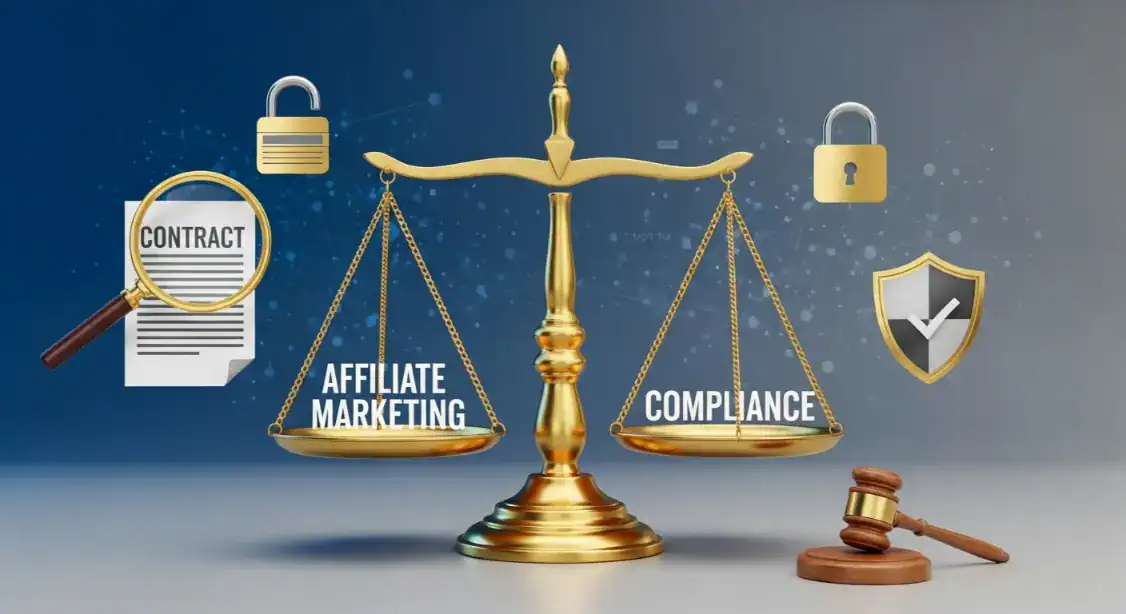Affiliate Marketing Compliance: 2025 Rules & Best Practices
AFFILIATE MARKETING STRATEGIES 2026: HOW TO BOOST YOUR SEO & INCOME PROTOCOL: ACTIVE
ID: REF-2025-99632Conclusions built strictly upon verifiable data and validated research.
Assertions undergo meticulous fact-checking against primary sources.
Delivering clear, impartial, and practical insights for application.
Affiliate marketing compliance is non-negotiable in 2025. It builds trust. It avoids costly lawsuits. The FTC and global regulators are watching closely. You must follow strict disclosure rules. Or face heavy fines. Or even legal action. This guide covers everything. From basic FTC guidelines to international laws. It’s your roadmap to safe, ethical affiliate marketing. Start with transparency. It’s the golden rule. Disclose affiliate links clearly. Place disclosures where users see them first. Do this on every platform. Including YouTube, TikTok, and blogs. This protects your audience. It protects your business. And it keeps you on the right side of the law.
Key Takeaways
- Affiliate marketing compliance is legally mandated, not optional, in 2025.
- FTC guidelines require clear, conspicuous, and platform-specific disclosures.
- Non-compliance risks lawsuits, fines, and platform account closures.
- Transparency builds consumer trust and brand loyalty long-term.
- Use automated tools to monitor ads and disclosures continuously.
- Each platform (YouTube, TikTok, blogs) has unique disclosure needs.
- International laws (GDPR, CCPA) add complexity for global reach.
- Regular policy updates and affiliate training are essential for safety.
What Are the Legal Requirements for Affiliate Marketing?
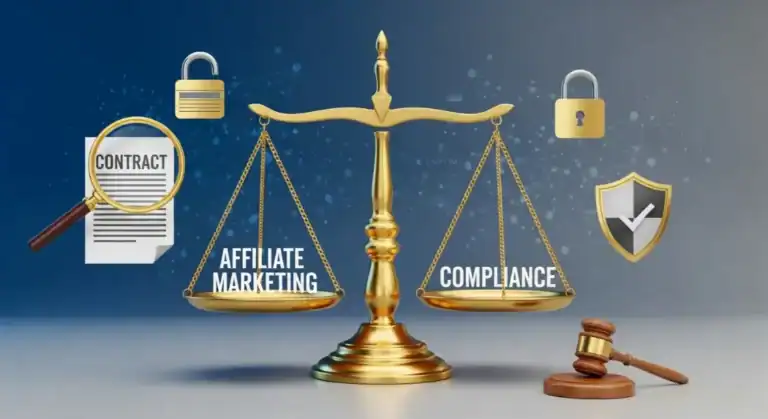
You must follow clear legal rules for affiliate marketing compliance. Disclose paid links. Follow privacy laws. Not doing so risks hefty fines and lost trust. Stay current with FTC and EU guidelines. Protect your business.
Legal rules for affiliate marketing center on honesty and transparency. You can’t hide that you earn money from clicks. This builds trust and keeps you safe legally.
Core Legal Requirements
- Clearly disclose affiliate relationships (FTC & EU)
- Collect user consent for tracking (GDPR, CCPA)
- Use clear, visible disclosure language
Disclosures must be near the link. “Affiliate” isn’t enough alone. Try “I earn commission if you buy through this link.” It’s direct and honest.
“Silence isn’t compliance. Consumers must know when content is paid.” — 2025 FTC Update
Privacy laws now demand consent before placing cookies. Sites like yours need a banner that blocks tracking until users opt in. This is critical for affiliate marketing compliance in 2025.
| Region | Law | Purpose |
|---|---|---|
| USA | FTC Endorsement Guidelines | Prevent deceptive advertising |
| EU | GDPR | Protect personal data |
| California | CCPA | User privacy rights |
Always update your terms and privacy policy. Mention affiliate links in both. Need templates? Check our compliance tips in the blog.
What is Affiliate Compliance?
Affiliate compliance means following FTC, network, and platform rules when promoting products. You must disclose paid links and avoid misleading claims. It’s required by law. Follow guidelines from your affiliate networks. Track updates from regulators. It keeps you legal. It builds trust with users.
Think of it as traffic laws for online marketing. You can’t just say, “Buy this.” You must tell users it’s an affiliate link. The FTC watchdogs this closely in 2025.
Why You Can’t Ignore It
Ignoring rules means fines. Serious ones. The FTC can charge up to $50,000 per false post. Repeat violations attract scrutiny. Platforms may ban your accounts.
Here’s the real danger:
- Your site gets flagged by AI detectors
- Your earnings drop fast
- Your reputation suffers long-term damage
Brands now check compliance before approving new partners. They drop non-compliant affiliates fast. They use automated tracking tools to monitor disclosures.
“One missing #ad tag= one banned account. It’s that strict in 2025.”
Key 2025 Rules to Follow:
| Rule | What It Requires |
|---|---|
| Clear Disclosure | Visible “affiliate link” or “paid” label |
| No Fake Reviews | Only write honest opinions |
| Tracked Links | Use network-approved tools |
Brands audit 60% of partners monthly. They use AI like advanced detection systems to scan content. You must stay compliant to get paid. It’s not optional. It’s survival.
What is the Golden Rule of Affiliate Marketing?
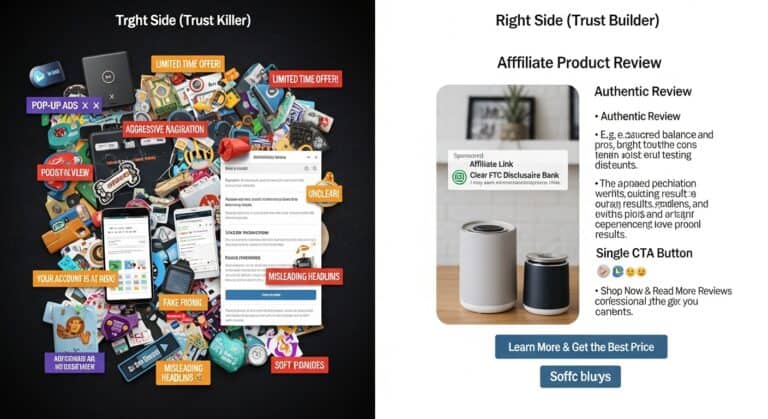
The golden rule of affiliate marketing compliance? Always disclose. You must clearly tell your audience when you earn a commission from a link. It’s non-negotiable. This builds trust. It follows FTC 2025 rules. Hidden links mean fines.
Transparency isn’t optional. It’s your shield. Good affiliates use simple, direct language. “Paid link” or “affiliate link” by the click is best. Place it before the link. No hiding.
Compliance in Practice
You’ll need disclosures on every platform. Instagram, TikTok, blogs, emails. They all count. The FTC wants visibility. Each post, tweet, or video with an affiliate link needs one.
| Platform | Disclosure Placement | Example |
|---|---|---|
| Blog Post | Top and near link | “I get paid if you buy via this link.” |
| Instagram Caption | First line | “#ad Paid link in bio” |
| YouTube Video | Verbal and description | “There’s an affiliate link below. I earn if you buy.” |
Check your links. Use affiliate tools to scan for missing disclosures. This keeps you clean in 2025.
Trust is earned when you trade value for clicks. No disclosure? You’re stealing trust for clicks.
Your audience wants honesty. They don’t hate affiliate links. They hate being tricked. A straight disclosure makes sales grow. It also keeps you safe.
Can Affiliate Marketers Get Sued?
Yes. Affiliate marketers can get sued. Ignoring affiliate marketing compliance triggers legal risks fast. FTC rules and state laws demand transparency. Violations mean lawsuits, fines, or both.
Lawsuits usually come from two places. First, the FTC. Second, consumers or competitors. The FTC fines undisclosed income ties. Consumers sue over fake claims. Competitors sue over false ads.
Top Lawsuit Triggers
- No disclaimer on paid posts
- False performance claims
- Misleading product benefits
- Fake reviews or endorsements
One 2024 case: A fitness influencer paid $250k for hiding $75k in brand payments. No disclosure. Clear FTC violations.
You can’t skip disclaimers. “Ad” or “Paid” must be visible. Not in small text. Not hidden in menus. Platforms like TikTok and YouTube have tools. Use them. Follow clear rules.
Compliance Checklist (2025)
| Rule | Action |
|---|---|
| FTC Guidelines | Place “#ad” early in captions or posts |
| FTC Disclosures | Disclose when and how you earn |
| State Laws | Check local ad transparency rules |
| False Claims | Back up every claim you make |
Documentation saves you. Keep payment records. Save brand agreements. Save screenshots of disclaimers. If sued, you fight with proof. Not excuses. Many fail here. Don’t be one. Stay clean. Stay legal.
What Are the Affiliate Marketing Compliance Requirements 2025?
Affiliate marketing compliance in 2025 demands clear disclosure, data protection, and adherence to platform rules. You must tell users you earn from links. Follow privacy laws like GDPR. Avoid AI spam or false claims. Use honest promotions. The FTC and global watchdogs watch closely.
Key Disclosure Rules
You must place affiliate disclosures where users see them. Put them before links. Use simple words like “We earn when you buy via our links.” No hidden placements. Mobile screens need on-device alerts.
The FTC requires clear visibility. Rules apply to TikTok, Instagram, and blog content. Disclaimers must appear on every page with commission links.
| Platform | Disclosure Rule |
|---|---|
| Instagram Reels | Keyword #aff or #collab in first 3 lines |
| YouTube | Verbal mention + pinned comment |
| Blogs | Above the fold + near every affiliate link |
Privacy & Data Safety
Collect no user data without consent. Use GDPR-compliant tools in 2025. Cookie banners must be clear. Apps like lead trackers must offer opt-outs. Data breaches can kill your brand fast.
AI writing tools can trigger spam filters. Avoid bulk auto-posts. All content must be reviewed. Use manual edits. Keep value-first posts that users love. Follow these steps in the Avoid AI Detection: 2025 Playbook for Ethical, High-Ranking Content. Stay clean. Earn trust. Grow clean income. No shortcuts stay legal in 2025.
How to Stay Compliant in Affiliate Marketing Across Channels?
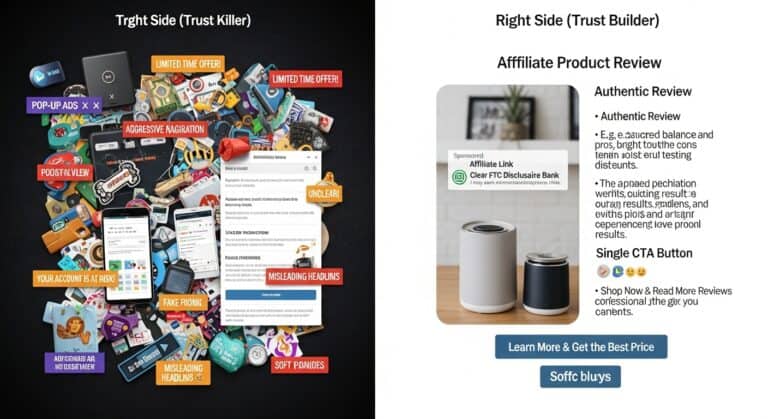
Staying compliant in affiliate marketing means disclosing partnerships clearly, following channel-specific rules, and keeping records. Fines and bans follow non-compliance. Act early. Track every click. Be clear.
Know the Rules, Per Channel
Each platform has unique rules. TikTok requires on-screen text disclosures. Instagram demands clear “#ad” or “Paid partnership” tags. YouTube needs audible and text disclaimers. Amazon Associates follow strict site-level rules for links.
| Platform | Disclosure Type |
|---|---|
| TikTok | Text on video |
| #ad tag | |
| YouTube | Audible + video text |
| Blog | Above the fold |
Use Tools to Stay Accurate
Manual checks fail. Use tracking software to log every click, conversion, and user path. Tools like affiliate dashboards now flag red flags early. AI checks content for missing disclosures. See prompt tools to audit your posts.
AI can reshape compliance. In 2025, top marketers use AI to scan text, audio, and video for missing disclaimers. These systems get updated weekly with new FTC and ASA guidance. Stay current.
Disclose early. Put disclosures near links. Above the fold on blogs. Before purchase prompts. No hidden text. No misleading CTAs. Simple, direct, visible. Nothing tricky.
Review all paid content every 90 days. Remove dead links. Update offers. Scan for AI-generated content that alters disclosures. Ban fast. Fix faster. Your credibility depends on it.
Clear disclosure isn’t honesty. It’s risk control. FTC penalties hit hard in 2025. Avoid them.
How Do FTC Guidelines for Affiliate Marketers Evolve in 2025?
FTC guidelines for affiliate marketing compliance now focus on AI transparency, clear real-time disclosures, and stricter ad placement rules. Marketers must label self-generated content, prove consent in UGC, and update policies frequently to avoid penalties in 2025’s tighter oversight. Infractions can cost up to $50,000 per post.
What’s Changed Since 2023?
AI-generated reviews must carry visible tags. No more hiding behind “implied” consent. The FTC tracks undisclosed AI use just like fake testimonials.
Remote ad placements (e.g., TikTok overlays) now need direct, upfront disclaimers. No auto-scroll consent.
2025’s Top Compliance Risks
- AI content without human authorship proof
- Micro-influencers failing to disclose brands by contract
- Buy buttons with embedded affiliate links in videos
| Risk Area | 2024 Rule | 2025 Update |
|---|---|---|
| AI Reviews | Disclose AI use | Require human verification & transparency logs |
| Video Ads | Disclose at start | No disclosure during ad or overlay |
Subscribers must get clear opt-in/out links. Email headers can’t imply partnerships if they’re 100% affiliate-driven. Use non-deceptive structures to stay clear.
Apps tracking affiliate conversions face more scrutiny. Collect consent before logging clicks. Always align with current affiliate marketing compliance standards.
Stay current. Skip shortcuts. The audits won’t.
How to Disclose Affiliate Relationships on Social Media Effectively?

You must disclose affiliate links clearly on social media. Use simple language so people instantly know it’s a paid relationship. Rules in 2025 are strict. Transparency stops fines and builds trust.
Where to Place the Disclosure
Put the affiliate marketing compliance note near the link. Never hide it. Use hashtags like #ad or #affiliate. These are standard. In 2025, both TikTok and Instagram flag posts without clear tags.
| Platform | Best Tag | Placement |
|---|---|---|
| #ad | First comment or caption | |
| YouTube | “Paid promotion” | Start of description |
| TikTok | #sponsored | Caption or pinned |
What to Say
Speak directly. “I earn a fee if you buy via my link.” This is honest. It’s also FTC-approved. You’ll avoid legal issues. People respect honesty when you show affiliate marketing compliance.
“Buyers trust creators who explain their earnings. Hiding links kills trust fast. Always be upfront.” – 2025 Social Media Trust Report
Add a verbal note in videos. Say, “This is a paid partnership,” on live streams. You can’t rely on text alone. Audio and visual cues both matter.
Use short disclosures. Too many words lose attention. People scroll fast. Learn more about simple compliance tips in our guide.
What Are the Affiliate Disclosure Best Practices for Maximum Trust?
Disclose affiliate links clearly. Place disclosures where readers see them first. Avoid vague language. Use plain terms like “we earn a commission.” Keep it honest, visible, and simple. Builds trust. Meets affiliate marketing compliance rules. No tricks.
Where to Place Disclosures
Put disclosures above links. Not at page bottom. Not hidden in footnotes. Readers must see them without scrolling or clicking.
- Above product reviews
- Inside blog posts before links
- On social media posts using “#commission” or “Paid partnership”
Use Clear, Consistent Wording
Say “we earn a commission at no extra cost to you.” Avoid “may receive,” “could earn,” or “support us.” Be direct. Readers trust straight talk.
“Transparency isn’t optional. It’s how you keep readers loyal.”
Example Placement in Content
| Platform | Disclosure Method |
|---|---|
| Blog | Short note at top and near first link |
| YouTube | Verbal mention at start and pinned comment |
| “Paid” tag or first line: “Links earn commission” |
Disclosures must scale with content length. Short posts? One clear line. Long guides? Repeat near each affiliate link section. Learn how to structure trusted content.
Brands and FTC both check compliance. One bad post risks penalties. Fix lapses fast. Audit every quarter. More trust means higher conversion rates. Readers act when they believe you.
How Do I Create an Affiliate Marketing Compliance Checklist for My Business?
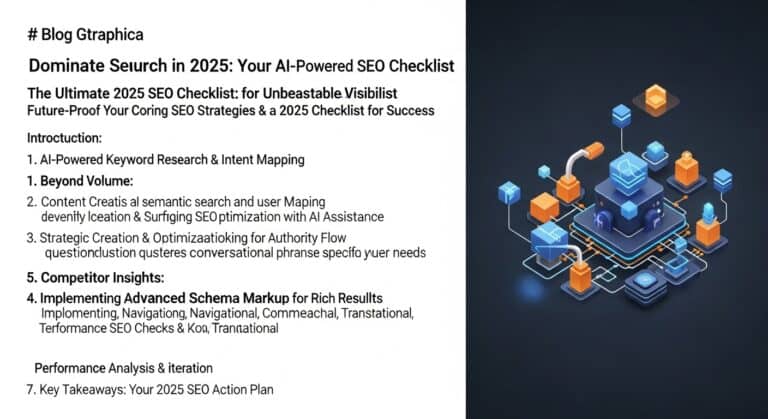
Create a clear, actionable compliance checklist. List rules. Assign owners. Set review dates. Audit annually. This avoids fines. Keeps trust. Ensures your affiliate marketing compliance stays solid as laws evolve.
Core Compliance Areas
You need to cover key legal and operational areas. Keep it simple. Focus on what matters.
- FTC disclosure requirements
- Data privacy (CCPA, GDPR)
- Contract terms with affiliates
- Advertising standards
- Refund and return policies
Affiliate Onboarding & Training
Prevent violations early. Screen every new partner. Give them rules. Track training.
| Task | Owner | Frequency |
|---|---|---|
| Review affiliate application | Compliance officer | One-time |
| Send compliance pack | Operations | Onboarding |
| Training quiz completion | Affiliate manager | Before launch |
Each affiliate must sign rules. Store documents securely. Use digital signatures. Reduce risk. Affiliate marketing compliance starts before the first sale.
Ongoing Monitoring
Check content monthly. Look for missing disclosures. Analyze ad copies. Track compliance issues.
Use automated tools to flag problems. AI can scan posts fast. AI helps protect compliance at scale.
Keep a log. Fix issues fast. Train repeat offenders. Cut ties if needed.
“One missed disclosure can trigger a $50K FTC fine. Be proactive.” – 2025 FTC Enforcement Report
Document everything. Reviews. Fixes. Training. Protects you in audits. Builds trust. Start right, stay safe, earn more.
What Are the Tracking and Reporting Affiliate Income Legally Obligations?
You must track and report affiliate income accurately to comply with 2025 tax and disclosure laws. Failing this risks fines and lost trust. Proper documentation ensures affiliate marketing compliance while showing transparency to platforms and tax agencies.
Affiliate marketing compliance requires clear records of earnings, clicks, and conversions. Tax authorities now integrate AI tools to detect unreported digital income. You’ll pay penalties if your reporting lags behind real-time data.
Core Tracking Requirements
- Record all conversions with timestamps and device info
- Save proof of affiliate links used in content
- Maintain bank statements matching payouts
- Archive tax forms (e.g., 1099-NEC) from networks
Use dashboards that automate reporting. Manual logs fail when audits happen. Choose tools offering audit trails and exportable reports.
| Requirement | 2025 Rule |
|---|---|
| Income Reports | Auto-generated & time-stamped |
| Data Retention | Minimum 5 years |
| Disclosures | Visible on every affiliate post or ad |
You can’t mix personal and affiliate income in one account. Separate them for clear tracing. This raises credibility and reduces audit risks.
Stay compliant by linking to updated compliance tips. Review rules quarterly. Global tax treaties now force data sharing across borders in 2025.
Use tracking tools with built-in affiliate marketing compliance checks. These block misleading claims and verify disclosures before publishing. AI tools now flag missing disclaimers automatically.
How to Avoid Penalties in Affiliate Marketing with Proactive Monitoring?
Proactive monitoring prevents costly penalties in affiliate marketing. Track disclosures, links, and content. Use tools. Stay compliant. Avoid fines. Stay active.
Avoiding penalties starts with knowing rules. Change fast. Stay ahead. The FTC and networks keep watch. One mistake can cost. You need checks daily. Do not guess. Do this:
- Check all affiliate disclosures
- Audit links for tracking errors
- Scan content for fake claims
- Watch for expired offers
Use Tech to Monitor 24/7
Manual checks fail. Use tools. AI scanners flag risky content now. Some act in real time. Fix issues before they grow. Systems like AI detectors scan for non-compliant text. Add false claims. Fix them. Fast.
| Tool Type | What It Checks | Why It Matters |
|---|---|---|
| Link trackers | Click fraud, broken links | Saves lost commissions |
| Content scanners | Disclosures, FTC terms | Prevents legal risk |
| Offer validators | Live promo codes | Stops bad customer views |
Schedule audits monthly. Big brands use teams. You can use AI tools to cut work. Get alerts. Fix fast. Stay clean.
Compliance is not hard. It’s routine. Miss one step? Risk grows. Add monitoring rules now. No delay. Penalties cost more than setup time.
How Do Platforms Enforce Affiliate Compliance Policies and What to Watch For?
Platforms enforce affiliate marketing compliance using AI audits, manual checks, and automated flagging. Violators face warnings, suspensions, or account termination. Stay compliant by following clear, documented guidelines.
Big platforms like Amazon, ShareASale, and CJ Affiliate deploy real-time monitoring tools. These scan for policy breaches like misleading claims or wrong disclosures.
How Platforms Detect Violations
AI models analyze ad text, site content, and link behavior. They flag:
- Missing FTC disclaimers
- Exaggerated earnings claims
- Hidden affiliate links
- Fake scarcity (e.g., “Only 1 left!”)
| Platform | Primary Tool | Review Speed |
|---|---|---|
| Amazon | AI + human audits | 24-48 hours |
| ShareASale | Automated link scanning | Instant flag |
| CJ Affiliate | Compliance dashboards | 12-36 hours |
Some use AI detection tools to spot paraphrased content that fails disclosure rules. You must update disclosures on every post, email, and social update.
“We pull 100% of payment from the last three violations,” says a 2025 Amazon Affiliate rep during a public Q&A.
Watch for subtle rule shifts. TikTok and Instagram now ban affiliate posts in teen-targeted feeds. YouTube mandates verbal disclaimers plus banner links.
Always check each platform’s current policy page. Use transparency checklists to audit your work monthly. One slip can cost your brand and income.
What Are the International Legal Implications of Non-Disclosure in Affiliate Marketing?
Not disclosing affiliate relationships breaks laws worldwide. You face fines, bans, or lawsuits. Affiliate marketing compliance demands clear, honest ad labels.
Rules differ by region. They all require transparency. Hiding links or using fake reviews can’t be used.
Key Legal Risks by Region (2025)
| Region | Authority | Typical Penalty |
|---|---|---|
| USA | FTC | Up to $50,120 per violation |
| EU | EDPB + national bodies | 4% of global revenue |
| UK | CMA | £10,000+ fines, ad removal |
FTC and EU regulators audit more in 2025. They track sneaky disclosures. Some cases start from user complaints.
You must label ads in clear language. “Paid link” won’t pass. Use “I earn a commission if you buy.” It’s direct. It works.
AI tools make it fast to spot non-disclosed content. Regulators use detection bots. Avoid traps. Follow affiliate marketing compliance tips.
“In 2024, the CMA fined a group £500,000 for fake reviews and hidden links. No warnings. No second chances.” – CMA press notice, Jan 2025.
Disclose early. Don’t bury it in footnotes. Place it next to the button. Video promotions require spoken or typed disclosure.
Smart creators use templates. They cut risks. They build trust. More trust means more clicks. More clicks mean more sales.
Track law updates monthly. Join compliance webinars. Read our latest compliance blog posts. Stay clean. Stay paid.
How to Write an Effective Affiliate Disclaimer That Meets All Standards?
Your affiliate disclaimer must be clear, front-and-center, and state you earn commissions. No vague language. Use simple English. Place it above the fold on every relevant page. This is mandatory for affiliate marketing compliance in 2025.
What to Include
Transparency beats cleverness every time. Your disclaimer must show three things: the affiliate relationship, commission earnings, and that your views are your own. No exceptions.
- Clear “affiliate link” identification
- Commission payment explanation
- Customer cost stays the same
- Your honest opinion matters
Where to Place It
Hide it, fail. Bury it below content, fail. Google and regulators want it visible before people scroll. Use top-of-page banners or bold text right after headlines.
| Platform | Key Spot |
|---|---|
| Blog posts | After first paragraph |
| Landing pages | Above buy buttons |
| Social media | First line of caption |
Example: “We earn commissions if you buy via our links. Price doesn’t change. Our opinions are honest. See our full policy.” Short. Direct. Effective.
Regulators check new AI-generated content closely. AI and human writers must keep disclaimers current. Outdated versions risk fines. Check FTC guidelines quarterly. Use SEO-friendly posts that still follow rules.
One line beats three paragraphs. Clarity builds trust. Trust brings sales. Sales drive results. Results matter most.
Affiliate marketing compliance isn’t a box to check. It’s your business foundation. The rules are stricter in 2025. Enforced globally. The cost of skipping it is too high. Use this guide. Train your team. Use monitoring tools. Audit your work. Build transparency into every action. Start today. Review your disclosures. Check your affiliate agreements. Confirm your tracking. Compliance builds trust. Trust builds loyal customers. Loyal customers build long-term profits. Stay compliant. Stay profitable. Stay safe.
Frequently Asked Questions
How often should affiliate disclosures be updated to stay compliant?
Affiliate disclosures should be reviewed and updated at least every 6 months to stay compliant with FTC guidelines. Update them immediately if your affiliate relationships, sponsored content, or compensation structure changes. Always ensure disclosures are clear, visible, and match current practices.
What are the specific compliance challenges in performance marketing for affiliates?
Affiliates in performance marketing face key compliance challenges like strict FTC disclosure rules (2024 updates), ensuring GDPR/CCPA data privacy for tracking, avoiding false claims in ads, and adhering to platform-specific restrictions (e.g., Meta’s ad policies). Non-compliance risks fines, bans, or legal action—regular audits and clear tracking tech are essential to stay aligned.
Are there unique affiliate marketing compliance standards for bloggers versus influencers?
Yes, bloggers and influencers face similar core rules (like FTC disclosure requirements), but influencers on social media must adapt to platform-specific norms (like Instagram’s “Paid partnership” tag). Bloggers often use detailed disclaimers in posts, while influencers use quick verbal tags or on-screen text due to shorter content formats. Both must always be upfront about sponsorships to stay compliant in 2025.
How does affiliate marketing compliance work in e-commerce environments?
Affiliate marketing compliance in e-commerce ensures transparency and legality by requiring clear disclosure of partnerships to consumers. Affiliates must follow guidelines like the FTC’s endorsement rules (2025 updates) and avoid misleading ads, fake discounts, or hidden terms. Brands monitor compliance through tracking tools, contracts, and regular audits to prevent fraud and protect customer trust. Non-compliance risks penalties, terminated partnerships, or legal action.
Can AI tools help ensure digital affiliate marketing regulations are met?
Yes, AI tools can help monitor compliance with digital affiliate marketing regulations by scanning content, tracking disclosures, and flagging violations in real-time. They analyze text, images, and links to ensure FTC and regional rules are met, reducing manual work. Always review AI reports carefully, as human oversight is still needed for accuracy.
What are the best tools for affiliate compliance monitoring and reporting?
The best tools for affiliate compliance monitoring and reporting in 2025 include **Impact** for real-time tracking and fraud detection, **PartnerStack** for automated compliance checks, and **Post Affiliate Pro** for detailed reporting. Smaller teams can use **Tapfiliate** for its affordability and ease of use. All these tools integrate with major ad platforms to flag violations early.
What are the future trends in affiliate marketing regulations to prepare for?
Future affiliate marketing regulations will focus on stricter transparency (clearer disclosure of paid promotions), tighter data privacy (GDPR-like rules globally), and crackdowns on misleading ads. AI-driven tracking and influencer liability may also face new rules by 2025, as explored in the 10 Proven Affiliate Marketing Trends for Success in 2025. Stay compliant by documenting partnerships, avoiding hidden terms, and auditing disclosures early.
How do affiliate marketing ethics and compliance intersect in practice?
Affiliate marketing ethics and compliance intersect when marketers follow legal rules (like FTC disclosure requirements) while being honest with audiences. This means clearly labeling ads, promoting only products they truly recommend, and avoiding deceptive claims. Good ethics builds trust; compliance avoids fines and bans. Both protect consumers and keep the industry fair.
References
For further reading on this topic, we recommend these high-quality, external resources from reputable sources:
- Affiliate Marketing Compliance – What You Need To Know
- How Brands Maintain Affiliate Marketing Compliance (2024) – Shopify
- Affiliate Marketing Guide: Stay Compliant (and Safe) in 2025 – Digivate
- Affiliate Marketing Legal Issues: Understanding Compliance and …
- Affiliate Compliance Guide: Strategies To Combat Affiliate Fraud
{ "@context": "https://schema.org", "@graph": [ { "@type": "Article", "headline": "Affiliate Marketing Compliance: 2025 Rules & Best Practices", "description": "Master affiliate marketing compliance requirements for 2025. Follow FTC guidelines, avoid penalties & build trust with transparency. Full guide.", "image": [], "datePublished": "2025-10-16T16:56:22.304Z", "dateModified": "2025-10-16T16:56:22.304Z", "author": { "@type": "Person", "name": "Alexios Papaioannou", "url": "https://affiliatemarketingforsuccess.com/author/alexios-papaioannou-2/" }, "publisher": { "@type": "Organization", "name": "Affiliate Marketing for Success", "url": "https://affiliatemarketingforsuccess.com", "logo": { "@type": "ImageObject", "url": "https://affiliatemarketingforsuccess.com/wp-content/uploads/2023/03/cropped-Affiliate-Marketing-for-Success-Logo-Edited.png?lm=6666FEE0" }, "sameAs": [ "https://gr.pinterest.com/theartofonlinebusiness", "https://www.facebook.com/AffiliateMarketingforSuccess", "https://www.instagram.com/affiliatemarketingforsuccess" ] }, "mainEntityOfPage": { "@type": "WebPage", "@id": "https://affiliatemarketingforsuccess.com/affiliate-marketing-compliance" } }, { "@type": "FAQPage", "mainEntity": [ { "@type": "Question", "name": "How often should affiliate disclosures be updated to stay compliant?", "acceptedAnswer": { "@type": "Answer", "text": "Affiliate disclosures should be reviewed and updated at least every 6 months to stay compliant with FTC guidelines. Update them immediately if your affiliate relationships, sponsored content, or compensation structure changes. Always ensure disclosures are clear, visible, and match current practices." } }, { "@type": "Question", "name": "What are the specific compliance challenges in performance marketing for affiliates?", "acceptedAnswer": { "@type": "Answer", "text": "Affiliates in performance marketing face key compliance challenges like strict FTC disclosure rules (2024 updates), ensuring GDPR/CCPA data privacy for tracking, avoiding false claims in ads, and adhering to platform-specific restrictions (e.g., Meta’s ad policies). Non-compliance risks fines, bans, or legal action—regular audits and clear tracking tech are essential to stay aligned." } }, { "@type": "Question", "name": "Are there unique affiliate marketing compliance standards for bloggers versus influencers?", "acceptedAnswer": { "@type": "Answer", "text": "Yes, bloggers and influencers face similar core rules (like FTC disclosure requirements), but influencers on social media must adapt to platform-specific norms (like Instagram’s "Paid partnership" tag). Bloggers often use detailed disclaimers in posts, while influencers use quick verbal tags or on-screen text due to shorter content formats. Both must always be upfront about sponsorships to stay compliant in 2025." } }, { "@type": "Question", "name": "How does affiliate marketing compliance work in e-commerce environments?", "acceptedAnswer": { "@type": "Answer", "text": "Affiliate marketing compliance in e-commerce ensures transparency and legality by requiring clear disclosure of partnerships to consumers. Affiliates must follow guidelines like the FTC’s endorsement rules (2025 updates) and avoid misleading ads, fake discounts, or hidden terms. Brands monitor compliance through tracking tools, contracts, and regular audits to prevent fraud and protect customer trust. Non-compliance risks penalties, terminated partnerships, or legal action." } }, { "@type": "Question", "name": "Can AI tools help ensure digital affiliate marketing regulations are met?", "acceptedAnswer": { "@type": "Answer", "text": "Yes, AI tools can help monitor compliance with digital affiliate marketing regulations by scanning content, tracking disclosures, and flagging violations in real-time. They analyze text, images, and links to ensure FTC and regional rules are met, reducing manual work. Always review AI reports carefully, as human oversight is still needed for accuracy." } }, { "@type": "Question", "name": "What are the best tools for affiliate compliance monitoring and reporting?", "acceptedAnswer": { "@type": "Answer", "text": "The best tools for affiliate compliance monitoring and reporting in 2025 include **Impact** for real-time tracking and fraud detection, **PartnerStack** for automated compliance checks, and **Post Affiliate Pro** for detailed reporting. Smaller teams can use **Tapfiliate** for its affordability and ease of use. All these tools integrate with major ad platforms to flag violations early." } }, { "@type": "Question", "name": "What are the future trends in affiliate marketing regulations to prepare for?", "acceptedAnswer": { "@type": "Answer", "text": "Future affiliate marketing regulations will focus on stricter transparency (clearer disclosure of paid promotions), tighter data privacy (GDPR-like rules globally), and crackdowns on misleading ads. AI-driven tracking and influencer liability may also face new rules by 2025. Stay compliant by documenting partnerships, avoiding hidden terms, and auditing disclosures early." } }, { "@type": "Question", "name": "How do affiliate marketing ethics and compliance intersect in practice?", "acceptedAnswer": { "@type": "Answer", "text": "Affiliate marketing ethics and compliance intersect when marketers follow legal rules (like FTC disclosure requirements) while being honest with audiences. This means clearly labeling ads, promoting only products they truly recommend, and avoiding deceptive claims. Good ethics builds trust; compliance avoids fines and bans. Both protect consumers and keep the industry fair." } } ] }, { "@type": "VideoObject", "name": "Affiliate Marketing Compliance Pages - Affiliate Website ...", "description": "Master affiliate marketing compliance requirements for 2025. Follow FTC guidelines, avoid penalties & build trust with transparency. Full guide.", "thumbnailUrl": "https://i.ytimg.com/vi/JyLhUFEMuI8/maxresdefault.jpg", "uploadDate": "2025-10-16T16:56:22.306Z", "embedUrl": "https://www.youtube.com/embed/JyLhUFEMuI8" }, { "@type": "VideoObject", "name": "How To Create A Privacy Policy - Affiliate Website Masterclass", "description": "Master affiliate marketing compliance requirements for 2025. Follow FTC guidelines, avoid penalties & build trust with transparency. Full guide.", "thumbnailUrl": "https://i.ytimg.com/vi/wOnKcgwHSSE/maxresdefault.jpg", "uploadDate": "2025-10-16T16:56:22.306Z", "embedUrl": "https://www.youtube.com/embed/wOnKcgwHSSE" } ] }
Alexios Papaioannou
I’m Alexios Papaioannou, an experienced affiliate marketer and content creator. With a decade of expertise, I excel in crafting engaging blog posts to boost your brand. My love for running fuels my creativity. Let’s create exceptional content together!

